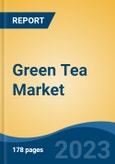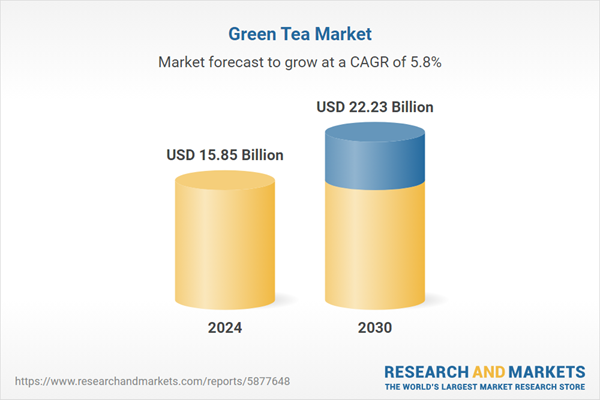Speak directly to the analyst to clarify any post sales queries you may have.
10% Free customizationThis report comes with 10% free customization, enabling you to add data that meets your specific business needs.
With consumers becoming more proactive about preventive healthcare, green tea has emerged as a preferred alternative to carbonated and sugary drinks, particularly among millennials and urban populations. The growing influence of wellness trends and fitness culture, further fueled by digital media and celebrity endorsements, is encouraging regular consumption of green tea as part of daily routines. Technological advancements in tea processing and flavor innovation - such as blends with herbs, fruits, and superfoods - are enhancing product appeal, especially among younger demographics seeking variety and taste without compromising on health benefits.
Additionally, rising disposable incomes, urbanization, and premium product launches are contributing to green tea’s mainstream adoption across both developed and developing economies. The surge in e-commerce platforms and the digital transformation of retail have also played a pivotal role, enabling easy accessibility to global brands and niche variants, especially in regions with limited physical retail infrastructure. Government initiatives promoting organic farming and sustainable agriculture, coupled with the increasing penetration of organized retail, are further catalyzing market growth.
Furthermore, the COVID-19 pandemic has significantly boosted demand for immunity-boosting and wellness-enhancing beverages, with green tea witnessing increased consumption during and post-pandemic periods. Countries such as China, Japan, and India continue to be key producers and consumers, while North America and Europe are rapidly expanding markets due to growing health awareness and a shift toward clean-label products. In the coming years, innovations in packaging, product convenience (like ready-to-drink formats), and functional enhancements (such as fortified or adaptogenic green teas) are expected to reshape consumer preferences. Sustainability trends, including eco-friendly packaging and ethical sourcing, are also emerging as important purchase drivers. Overall, the green tea market is poised for sustained growth through 2030, driven by a confluence of lifestyle changes, product innovation, digital retail expansion, and health-driven consumer choices.
Market Drivers
Rising Health Consciousness and Preventive Healthcare Trends
One of the most significant drivers propelling the global green tea market is the surge in health consciousness among consumers. In recent years, people across both developed and developing nations have become increasingly aware of the importance of maintaining a healthy lifestyle to prevent chronic diseases such as obesity, diabetes, cardiovascular ailments, and certain cancers. India’s Longitudinal Ageing Study in India (LASI) (conducted by the International Institute for Population Sciences) revealed undetected chronic disease prevalence among older adults (ages 45+). Lab tests found diabetes in 13.3% of the 45-59 age group and 16.2% of those aged 60+ - higher than self-reported rates of 9.2% and 14.2% respectively.Green tea, known for its high concentration of antioxidants, polyphenols (especially catechins like EGCG), and metabolism-boosting properties, is widely recognized for its health benefits, making it a natural choice for health-aware individuals. As consumers adopt preventive healthcare strategies over curative solutions, green tea has gained traction as a daily wellness beverage. The growing popularity of detox diets, intermittent fasting, and weight management regimens has further encouraged green tea consumption due to its natural fat-burning and digestive aid properties.
Additionally, the rise in stress-related health concerns and mental well-being issues has prompted interest in calming beverages like green tea, which contains theanine, an amino acid known to reduce anxiety and improve focus. With more people seeking natural, functional alternatives to synthetic supplements or heavily processed foods, green tea aligns well with clean-label and plant-based preferences. As a result, consumers are integrating green tea into their daily routines - whether as a morning ritual, a mid-day refreshment, or a pre/post-workout drink - further driving consistent demand globally.
Key Market Challenges
High Price Sensitivity and Limited Affordability in Emerging Markets
Despite the growing global awareness of green tea’s health benefits, its relatively higher price point compared to regular black tea or local herbal infusions continues to act as a barrier in price-sensitive markets, particularly in lower-income and rural regions across Asia, Africa, and Latin America. The production of high-quality green tea involves specific cultivation and processing methods - such as minimal oxidation, controlled drying, and sometimes handpicking - which increases labor and operational costs. According to the Tea Board of India and Ministry analyses, labour accounts for over 60 % of total tea production costs, with manufacturing and administrative expenses comprising most of the remainder.Furthermore, organic and premium variants are priced significantly higher due to strict certification requirements and sustainable sourcing practices. For consumers in developing economies, where disposable income is limited and traditional dietary habits dominate, the perceived cost-to-benefit ratio of green tea may not justify regular purchases. As a result, green tea often remains a niche product among upper-middle and affluent segments.
In addition, fluctuating global tea prices due to climate-related disruptions and geopolitical trade tensions further impact pricing stability, which affects both producers and end consumers. Although there are efforts to introduce low-cost, mass-market green tea options, such versions may compromise on quality or taste, leading to poor consumer retention. Therefore, price remains a key bottleneck in expanding the green tea market to broader demographics, limiting its penetration outside urban centers and premium wellness segments.
Key Market Trends
Emergence of Functional Green Tea Beverages for Targeted Wellness Needs
A notable trend gaining momentum in the green tea market is the evolution of green tea from a general health beverage to a functional wellness product, with formulations tailored to address specific health concerns. Consumers today are increasingly seeking products that offer targeted benefits beyond basic nutrition, including immunity boosting, cognitive enhancement, detoxification, digestive support, skin health, weight management, and stress reduction. In response, manufacturers are integrating green tea with a range of bioactive ingredients such as vitamins (B12, C, D), minerals (zinc, magnesium), probiotics, collagen, L-theanine, ginseng, turmeric, moringa, and adaptogenic herbs like ashwagandha and rhodiola.These hybrid blends appeal to a diverse consumer base looking for convenient, ready-to-consume beverages that support holistic wellness. The post-COVID-19 health consciousness has significantly accelerated the popularity of such functional beverages, with green tea offering a natural, caffeine-containing base that aligns well with the clean-label trend. Additionally, brands are offering personalized green tea formulations for different age groups, genders, or activity levels - such as teas for athletes, working professionals, or seniors - which creates a premium value proposition. This trend is redefining green tea from being a mere detox beverage to a category within the nutraceuticals and functional drinks space, offering a multitude of health-enhancing options that serve evolving consumer needs.
Key Market Players
- Associated British Foods plc
- The Republic of Tea Inc.
- Unilever plc
- Tata Consumer Products Limited
- The Bigelow Tea Company
- East West Tea Company LLC
- SHANGRI-LA TEA COMPANY INC.
- Numi Inc.
- Keurig Dr Pepper Inc
- Teavana Corporation.
Report Scope:
In this report, the global Green Tea market has been segmented into the following categories, in addition to the industry trends which have also been detailed below:Green Tea Market, By Product Type:
- Flavored
- Unflavored
Green Tea Market, By Form:
- Tea Bags
- Powder
- Loose Leaves
Green Tea Market, By Distribution Channel:
- Supermarkets/Hypermarkets
- Convenience Stores
- Departmental Stores
- Online
- Others
Green Tea Market, By Region:
- North America
- United States
- Canada
- Mexico
- Europe
- France
- Germany
- Spain
- Italy
- United Kingdom
- Asia-Pacific
- China
- Japan
- India
- Vietnam
- South Korea
- Middle East & Africa
- South Africa
- Saudi Arabia
- UAE
- Turkey
- Kuwait
- Egypt
- South America
- Brazil
- Argentina
- Colombia
Competitive Landscape
Company Profiles: Detailed analysis of the major companies present in the global Green Tea market.Available Customizations:
With the given market data, the publisher offers customizations according to a company's specific needs. The following customization options are available for the report.Company Information
- Detailed analysis and profiling of additional market players (up to five).
This product will be delivered within 1-3 business days.
Table of Contents
Companies Mentioned
- Associated British Foods plc
- The Republic of Tea Inc.
- Unilever plc
- Tata Consumer Products Limited
- The Bigelow Tea Company
- East West Tea Company LLC
- SHANGRI-LA TEA COMPANY INC.
- Numi Inc.
- Keurig Dr Pepper Inc
- Teavana Corporation.
Table Information
| Report Attribute | Details |
|---|---|
| No. of Pages | 188 |
| Published | September 2025 |
| Forecast Period | 2024 - 2030 |
| Estimated Market Value ( USD | $ 15.85 Billion |
| Forecasted Market Value ( USD | $ 22.23 Billion |
| Compound Annual Growth Rate | 5.8% |
| Regions Covered | Global |
| No. of Companies Mentioned | 10 |









